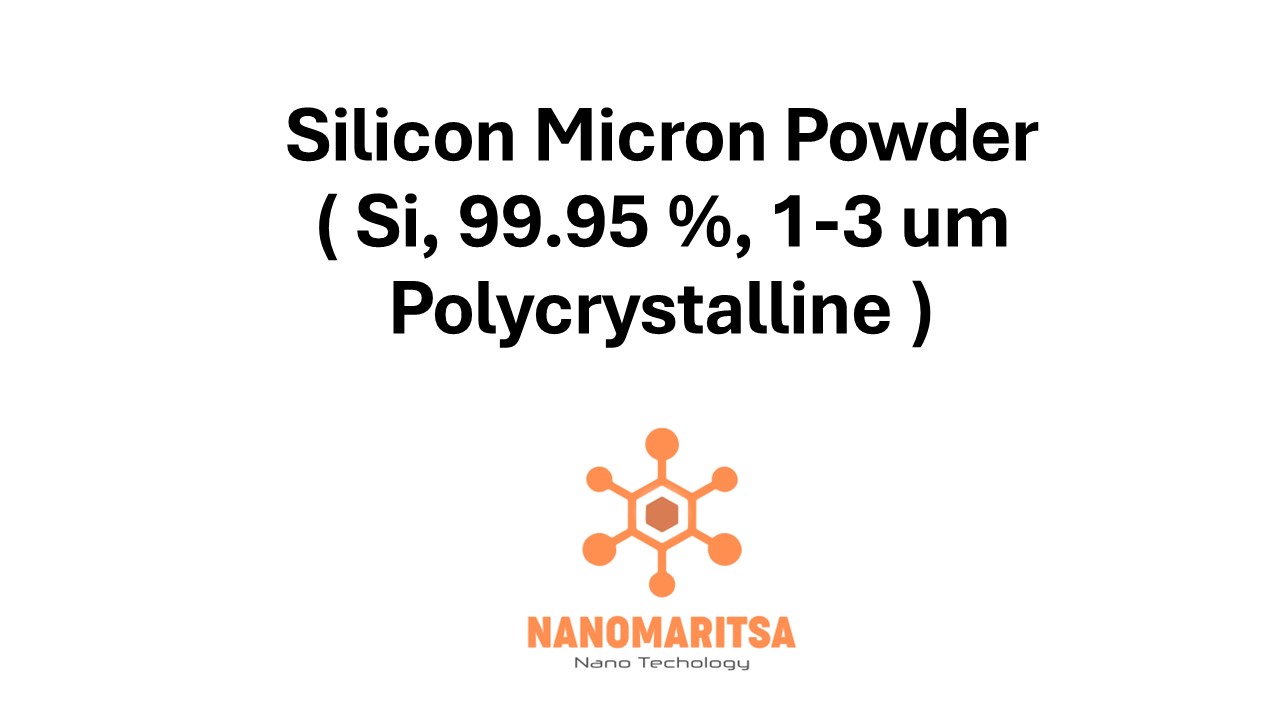Silicon Micron Powder (Si, 99.95%, 1–3 µm, Polycrystalline) is a high-quality silicon powder characterized by its polycrystalline structure and 99.95% purity. With particle sizes ranging from 1 to 3 micrometers, this material balances surface area and flowability, making it an excellent choice for precision-driven industries. The polycrystalline nature of the powder, composed of multiple crystal grains, can enhance its mechanical and thermal properties—an advantage in advanced manufacturing processes such as ceramics production, electronics, and energy storage solutions. Silicon’s semiconductor capabilities, combined with its robust thermal stability, underpin its value in technologies ranging from solar cells to microelectronics.
- Key Properties
- High Purity (99.95%): Minimal impurities ensure reliable performance in critical applications such as microelectronics, photovoltaics, and battery systems, where chemical consistency is paramount.
- Particle Size (1–3 µm): The fine particle range offers an expansive surface area for improved reactivity, yet maintains sufficient flow characteristics for efficient handling and processing.
- Polycrystalline Structure: Multiple crystal grains within each particle can provide enhanced mechanical robustness, helping parts withstand stress and high-temperature conditions in manufacturing.
- Semiconducting Behavior: Silicon remains the foundation of modern electronics due to its well-studied and controllable electrical properties, making it indispensable for integrated circuits and sensors.
- Thermal Stability: Silicon’s high melting point and strong thermal conductivity aid in heat dissipation, supporting applications like power electronics and high-temperature manufacturing setups.
- Applications
- Electronics and Semiconductors: Polycrystalline silicon powders are used to fabricate wafers, conductive pastes, and components in microelectronics, sensors, and integrated circuits.
- Solar Energy (Photovoltaics): Silicon is the principal material in photovoltaic cells, converting sunlight into electricity. Polycrystalline powders can assist in producing cost-effective and efficient solar solutions.
- Battery Technologies: As research delves into silicon anodes for lithium-ion batteries, fine polycrystalline powders show promise in boosting energy density and enhancing battery life.
- Advanced Ceramics: Silicon-based ceramic composites leverage the powder’s purity and thermal stability, yielding components with high hardness and strong resistance to wear or thermal shock.
- Coatings and Composites: The powder’s fine particle size and robust properties help improve coating uniformity and mechanical strength in composite materials intended for industrial or high-tech applications.
- Advantages
- Enhanced Reactivity: The fine, uniform particle size expands the powder’s surface area, enabling faster reaction rates in processes like sintering, chemical vapor deposition, or battery electrode formulation.
- Consistent Distribution: A controlled particle size range (1–3 µm) ensures even dispersion in slurries, inks, and composite matrices, reducing defects and enhancing product reliability.
- Thermal Reliability: The polycrystalline form of silicon demonstrates dependable performance under high temperatures, making it suitable for harsh operating environments like engine components or high-powered electronics.
- Mechanical Robustness: Polycrystalline grains confer improved toughness and resistance to cracking compared to single-crystal alternatives, extending the service life of manufactured parts.
- Broad Manufacturing Compatibility: Whether employed in powder metallurgy, 3D printing, or thin-film deposition, this silicon powder adapts readily to modern production techniques due to its purity and particulate consistency.
- Recent Trends and Research
- High-Efficiency Solar Cells: Developers explore ways to optimize polycrystalline silicon layers to boost solar panel output while cutting material costs, aiming for broader renewable energy adoption.
- Silicon Anodes in Batteries: Significant efforts target the stabilization of silicon anodes, seeking to solve issues like volume expansion and material degradation for longer-lasting lithium-ion cells.
- Flexible Electronics: Nanoscale and microscale silicon powders are advancing the production of bendable circuits, sensors, and wearable technologies that require durable semiconducting materials.
- Advanced Ceramics & Composites: Research continues to refine high-temperature and corrosion-resistant ceramic matrices using silicon powders, enabling more robust applications in aerospace and manufacturing.
- Nanostructured Films: Investigations into silicon thin films, including polycrystalline varieties, are making headway in miniature electronics, photonics, and specialized coatings that offer unique optical or protective properties.
- Future Prospects
- Next-Generation Energy Storage: As the push for more efficient batteries intensifies, silicon’s considerable lithium storage capacity could position it as a key player in emerging energy solutions.
- Scaling Solar Adoption: Continued improvements in polycrystalline silicon production and solar cell efficiency have the potential to make solar energy more widespread and cost-competitive.
- Advanced Semiconductor Architectures: With electronics rapidly evolving, ultrafine, high-purity silicon powders will remain integral to next-level chip designs, MEMS devices, and other micro-scale technologies.
- Greener Manufacturing Techniques: Scientists and industry leaders are collaborating on sustainable production methods for silicon powders, including recycling and reduced-energy refinement processes.
- Expanded Industry Integration: Beyond traditional electronics and photovoltaics, sectors such as automotive, aerospace, and medical devices may increasingly incorporate polycrystalline silicon powders for specialized components and solutions.
Bolstered by its excellent purity, controlled particle size, and polycrystalline structure, Silicon Micron Powder (Si, 99.95%, 1–3 µm, Polycrystalline) remains a foundational material across a range of high-tech domains. From next-generation battery electrodes and innovative solar cells to precision electronics and temperature-resistant ceramics, its versatility ensures that silicon will continue to shape the future of advanced manufacturing and sustainable technology solutions.
| Measurement (gr) | 100 grams, 500 grams, 1000 grams |
|---|






